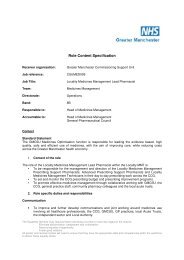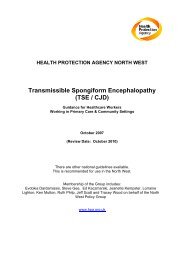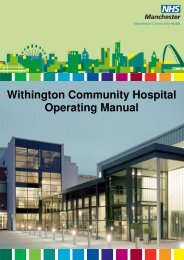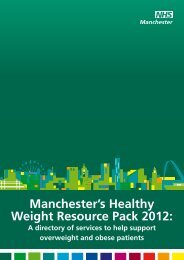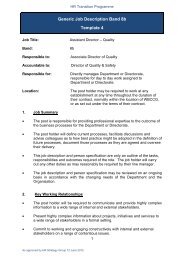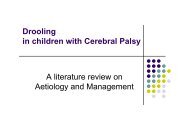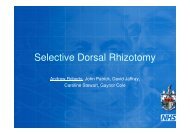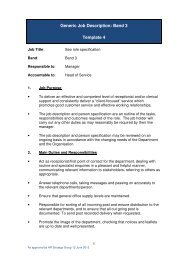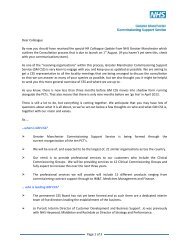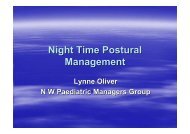Prevention of Occupational Exposure to Blood Borne Viruses
Prevention of Occupational Exposure to Blood Borne Viruses
Prevention of Occupational Exposure to Blood Borne Viruses
Create successful ePaper yourself
Turn your PDF publications into a flip-book with our unique Google optimized e-Paper software.
<strong>Prevention</strong> <strong>of</strong> <strong>Occupational</strong><br />
<strong>Exposure</strong> <strong>to</strong> <strong>Blood</strong> <strong>Borne</strong> <strong>Viruses</strong><br />
Beverly Lamb<br />
Specialist Dental Infection Control Nurse
Policy<br />
PREVENTION AND MANAGEMENT OF OCCUPATIONAL<br />
EXPOSURE TO BLOOD BORNE VIRUSES POLICY<br />
The policy should include:<br />
• Types & transmission <strong>of</strong> BBV’s<br />
• Management <strong>of</strong> <strong>Exposure</strong> <strong>to</strong> BBV – inoculation injury management<br />
• <strong>Occupational</strong> Health Services<br />
• Risk Reduction and <strong>Prevention</strong>
Standard Precautions<br />
Everybody should be treated as possibly infectious. All blood and body<br />
fluids are potentially infectious and precautions are necessary <strong>to</strong><br />
prevent exposure <strong>to</strong> them<br />
Standard Principles <strong>of</strong> Infection Control/Universal Precautions include:<br />
• Hand Hygiene<br />
• Protective Clothing<br />
• Safe Handling <strong>of</strong> Sharps (including Sharps Injury Management)<br />
• Spillage Management.
How can we reduce the risk<br />
PPE<br />
Immunisation<br />
hand hygiene<br />
Spillage management<br />
Management <strong>of</strong> sharps<br />
Decontamination<br />
Waste Disposal<br />
Cleaning
<strong>Occupational</strong> Health<br />
Manchester PCT have arranged access <strong>to</strong> occupational health services<br />
for dentists who hold NHS dental contracts and their staff<br />
For new staff<br />
• Pre-employment health assessment including HIV,<br />
Hepatitis C, Hepatitis B, TB status checks and blood<br />
tests<br />
• For existing staff<br />
• Vaccination updates including Hepatitis B & TB<br />
• Needle stick/chemical splash injury advice<br />
• Treatment service for work-related problems
Contact Details<br />
For practices based in North and Central Manchester<br />
For practices based in South Manchester<br />
North Manchester General Hospital<br />
The <strong>Occupational</strong> Health Department<br />
North Manchester General Hospital<br />
Delaunays Road<br />
Crumpsall<br />
Manchester<br />
M8 5RB<br />
Tel: 0161 720 2727<br />
Wythenshawe Hospital<br />
The <strong>Occupational</strong> Health Office<br />
Wythenshawe Hospital<br />
Southmoor Road<br />
Manchester<br />
M23 9LT<br />
Tel: 0161 291 4209 or<br />
291 2825
Types <strong>of</strong> PPE<br />
•Disposable gloves<br />
•Disposable plastic aprons<br />
•Protective eye equipment<br />
•Masks<br />
•Visors<br />
•Heavy Duty Gloves
Research<br />
• A study <strong>of</strong> manual cleaning <strong>of</strong> instruments showed that<br />
viable bacteria were detected on agar plates attached <strong>to</strong><br />
the nurses mask (Eisen et el 2006)<br />
• A survey carried out in Canada in 2006 revealed that out<br />
<strong>of</strong> 924 sharps injuries recorded 183 were sustained<br />
during manual cleaning <strong>of</strong> instruments (Shah et el 2006)
PPE<br />
• Selection <strong>of</strong> PPE will be dependent upon risk <strong>of</strong><br />
contamination <strong>of</strong> staff clothing and skin by patient’s<br />
blood, body fluid, secretions and excretions<br />
No exposure <strong>to</strong> blood /<br />
bodily fluids<br />
anticipated<br />
<strong>Exposure</strong> anticipated<br />
but low risk <strong>of</strong><br />
splashing<br />
<strong>Exposure</strong> anticipated<br />
and high risk <strong>of</strong><br />
splashing<br />
No PPE<br />
Gloves<br />
Gloves, gown &<br />
Face / eye<br />
protection
Gloves<br />
• Non-latex hypoallergenic gloves must be available for<br />
use with staff with latex allergy (not vinyl)<br />
• Sterile gloves should always be used for aseptic<br />
procedures and all surgical procedures.<br />
• Gloves are NOT a substitute for good hand hygiene<br />
• NEVER perform hand hygiene whilst wearing gloves<br />
including hand rub)<br />
• Remove gloves immediately after use before <strong>to</strong>uching<br />
non contaminated clean areas / items
Gloves<br />
• Gloves protect the hands <strong>of</strong> healthcare workers from chemicals and<br />
or bodily fluids.<br />
• Heavy Duty gloves for handling contaminated instruments and<br />
during cleaning tasks also give some protection from sharps injury<br />
• Should be well fitting <strong>to</strong> avoid difficulties with dexterity, excessive<br />
sweating and finger / hand muscle fatigue<br />
• Non-sterile powder free latex gloves should be used for procedures<br />
where this is an actual or potential risk <strong>of</strong> contact with blood or body<br />
fluids or equipment contaminated with body substances, non-intact<br />
skin, or mucous membrane.
Aprons<br />
• These should be worn <strong>to</strong> protect clothing from possible<br />
contamination, they must be single patient use, and<br />
removed after the task has been completed and<br />
disposed <strong>of</strong> as clinical waste.
Face / mouth / eye Protection<br />
• Safety Goggles & mask / Visor<br />
• Full eye / face protection should be readily available for use when there is a<br />
risk <strong>of</strong> splashing with blood or body fluids or flying debris!<br />
• Masks should fit comfortably over covering mouth and nose and should be<br />
removed when not in use and NOT worn around neck<br />
• Goggles should give full protection “wrap around” the eye area <strong>of</strong>fering side<br />
protection<br />
• Eye / face protection should be disposed <strong>of</strong> after each use (if single use) or<br />
cleaned with warm soapy water between usage<br />
• IF worn masks are SINGLE USE and should be changed after each patient<br />
• Face protection should not be <strong>to</strong>uched whilst being worn
SELECTION OF PPE<br />
Assisting with routine examination<br />
Transporting instruments <strong>to</strong> decontamination room<br />
Surgery wash down / cleaning<br />
Packaging sterilised instruments<br />
Assisting in surgical extraction<br />
Manually Cleaning Instruments
Good Practice<br />
• Kept at point <strong>of</strong> use (Keep in clean zone in appropriate container <strong>to</strong><br />
reduce risk <strong>of</strong> contamination with aerosols)<br />
• S<strong>to</strong>ck should be s<strong>to</strong>red in a clean, dry place above floor level,<br />
• Keep PPE in original boxes so with expiry dates can be observed<br />
and their integrity maintained.<br />
• DO NOT keep gloves in pockets<br />
• Dispose <strong>of</strong> used PPE immediately in appropriate bin<br />
• Re-usable PPE should be cleaned after use (goggles / visors) and<br />
should never be placed on clean surfaces<br />
• Remove PPE before leaving area / moving <strong>to</strong> a different area or<br />
before contact with clean areas / surfaces
Removal <strong>of</strong> PPE<br />
1. Gloves<br />
2. Apron<br />
3. Eye protection<br />
4. Mask
Inoculation Injury - Definition<br />
• Needle-stick or Sharps injury:<br />
• Human bites and scratches which break the skin and<br />
involve visible blood<br />
• Contamination or splashing <strong>of</strong> the conjunctiva and<br />
mucous membranes (eyes, nose, mouth) with blood or<br />
body fluids.<br />
• Contamination or splashing <strong>of</strong> any open wound or skin<br />
lesion e.g. eczema or psoriasis with blood or body fluids
Safe Management <strong>of</strong> sharps<br />
GROUP ACTIVITY<br />
What precautions should be taken when dealing with sharps :<br />
whether preparing <strong>to</strong> carry out or during a procedure or when<br />
handling or disposing <strong>of</strong> sharps.
Safe Management <strong>of</strong> sharps<br />
• Never leave sharps lying around<br />
• Place containers at point <strong>of</strong> use positioned safely (not on floor or<br />
above shoulder height)<br />
• Never force equipment <strong>of</strong> any kind in<strong>to</strong> sharps containers.<br />
• Never attempt <strong>to</strong> retrieve anything from inside sharps containers.<br />
• Never place sharps containers in public access areas (e.g.<br />
corridors, entrances, exits, within easy reach <strong>of</strong> children, etc.).<br />
• Ensure temporary closure <strong>of</strong> the sharps bin during transportation.<br />
• Secure and replace containers when they are ¾ full or are<br />
approaching this level.
Safe Management <strong>of</strong> Sharps<br />
• Do not “pass” sharps – You use it You bin it!<br />
• Use safe devices if re-sheathing<br />
• Use gloves where possible-cannot prevent percutaneous<br />
injury but may reduce the risk <strong>of</strong> acquiring a BBV infection<br />
• Ensure competence<br />
• Discard disposable syringes and needles as a single unit<br />
• Place all disposable sharps in UN approved sharps<br />
containers immediately after use
Guidance for Clinical Health Care Workers: Protection Against<br />
Infection with <strong>Blood</strong>-borne <strong>Viruses</strong><br />
http://www.dh.gov.uk/prod_consum_dh/groups/dh_digitalassets/@dh/@en/docume<br />
nts/digitalasset/dh_4014474.pdf
Spillage Management<br />
• <strong>Viruses</strong> such as Hep B, Hep C and HIV can be<br />
transmitted through blood and other bodily fluids<br />
• Quick and effective management will reduce the risk <strong>of</strong><br />
transmission <strong>of</strong> infection
Management<br />
• Written pro<strong>to</strong>col<br />
• Appropriate products<br />
• Provision <strong>of</strong> training<br />
• Staff immunised against Hep B<br />
• COSHH assessment<br />
• Incident reporting
Cleaning agents<br />
• Chlorine-releasing agents are chemicals disinfectants<br />
which are effective against blood-borne viruses<br />
• Use fresh solution according <strong>to</strong> manufacturers<br />
instructions and discard after use<br />
Chlorine-releasing agents fall in<strong>to</strong> two groups:<br />
• Sodium dichloroisocyanurate (NaDCC) e.g. Haz tabs,<br />
Presept<br />
• Sodium hypochlorites e.g. Domes<strong>to</strong>s, Mil<strong>to</strong>n
Chlorine Concentrations<br />
• 10,000 ppm used for decontamination <strong>of</strong> spillages <strong>of</strong><br />
blood or bodily fluids stained with blood<br />
• 1,000ppm used for disinfection <strong>of</strong> surfaces following<br />
contamination with other bodily fluids (<strong>to</strong> be used after<br />
cleaning with a detergent)
Safety<br />
• Keep area well ventilated<br />
• Chlorine-releasing agents are corrosive <strong>to</strong> many materials e.g.<br />
metals, and will bleach carpets, fabrics and s<strong>of</strong>t furnishings.<br />
• Chlorine-releasing agents can damage the skin and mucous<br />
membranes, therefore gloves and aprons should be worn for any<br />
contact. If there is a risk <strong>of</strong> splashing eye protection should be worn.<br />
• Chlorine-releasing agents must not be used on spills <strong>of</strong> urine<br />
as chlorine gas will be released.
Pro<strong>to</strong>col – non blood bodily fluids<br />
• Prepare equipment<br />
• Put on PPE<br />
• Remove heavy soiling with paper <strong>to</strong>wels<br />
• Clean with GPD and hand hot water with single use wipes (paper<br />
<strong>to</strong>wels) in jug/bowl<br />
• Disinfect with 1,000ppm solution<br />
• Rinse and dry<br />
NEVER USE SODIUM HYPOCHLORITE DIRECTLY ON URINE SPILLAGE
Pro<strong>to</strong>col – blood spillage<br />
• Cover spillage with NaDCC (chlorine-releasing) granules<br />
& leave for 2 minutes.<br />
• Scoop up the spillage with scoop and scrapper and<br />
discard as clinical waste<br />
• Clean area with hot water and detergent using paper<br />
<strong>to</strong>wels then rinse<br />
• Use a solution <strong>of</strong> 10,000ppm sodium hypochlorite with<br />
paper <strong>to</strong>wels <strong>to</strong> wipe the area <strong>of</strong> any remaining spill<br />
• place all materials, gloves last <strong>of</strong> all in clinical waste
Minor blood spills - Splashes / drips<br />
• Drips or splashes <strong>of</strong> blood on inanimate surfaces should<br />
be wiped up using a paper <strong>to</strong>wel soaked with sodium<br />
hypochlorite 1% (10,000ppm)<br />
• Wear PPE and ventilate the room<br />
• Dispose <strong>of</strong> all waste in<strong>to</strong> clinical waste bag<br />
• Ensure that area is rinsed using cold water following<br />
disinfectant




